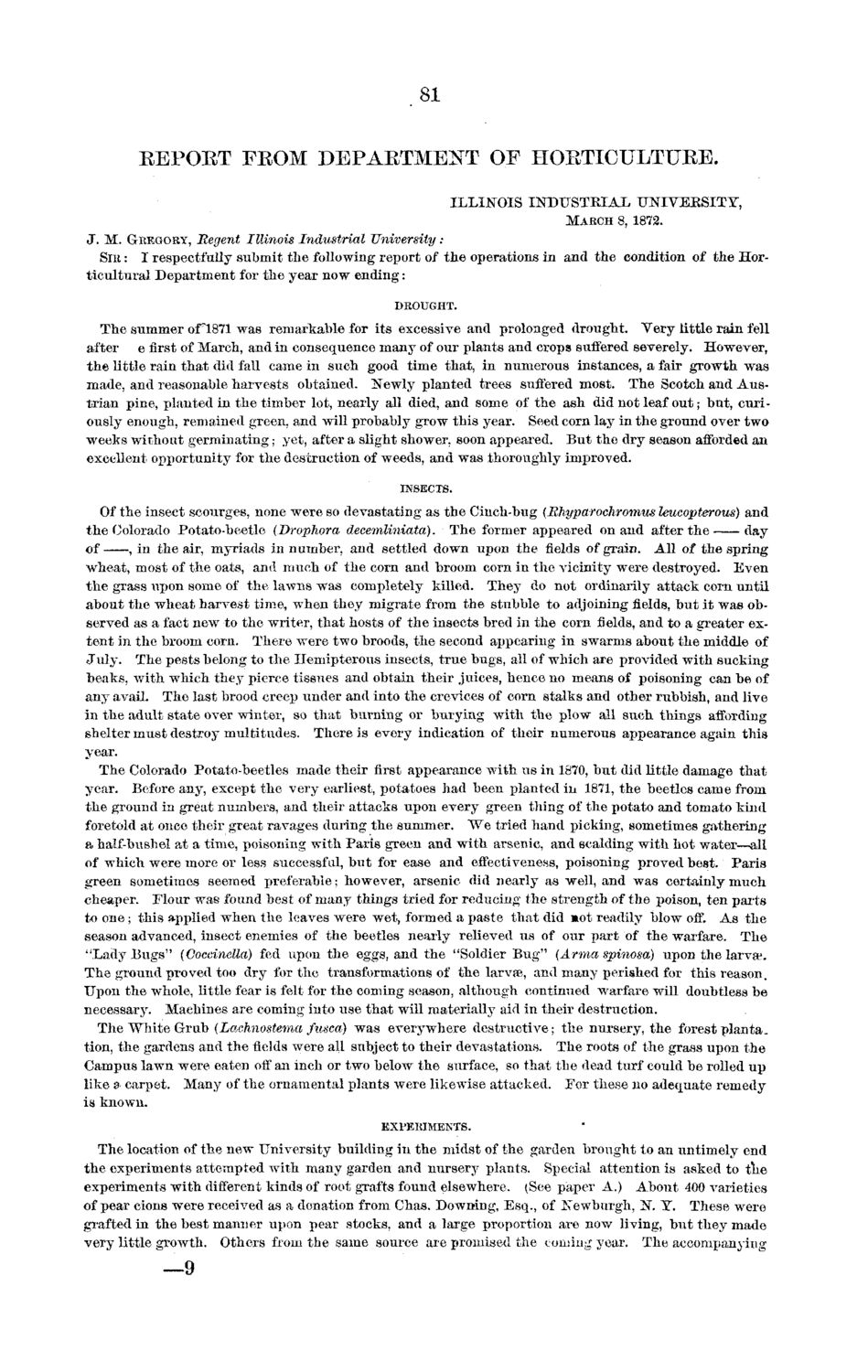| |
| |
Caption: Board of Trustees Minutes - 1872
This is a reduced-resolution page image for fast online browsing.

EXTRACTED TEXT FROM PAGE:
81 KEPORT FEOM DEPARTMENT OF HORTICULTURE. ILLINOIS INDUSTRIAL UNIVERSITY, MARCH 8, 1872. J . M. GREGORY, Regent Illinois Industrial University: SIR : I respectfully submit the following report of the operations in and the condition of the Horticultural Department for the year now ending: DROUGHT. The summer of!871 was remarkable for its excessive and prolonged drought. Very little rain fell after e first of March, and in consequence many of our plants and crops suffered severely. However, the little rain that did fall came in such good time that, in numerous instances, a fair growth was made, and reasonable harvests obtained. Newly planted trees suffered most. The Scotch and Austrian pine, planted in the timber lot, nearly all died, and some of the ash did not leaf out; but, curiously enough, remained green, and will probably grow this year. Seed corn lay in the ground over two weeks without germinating; yet, after a slight shower, soon appeared. But the dry season afforded an excellent opportunity for the destruction of weeds, and was thoroughly improved. INSECTS. Of the insect scourges, none were so devastating as the Cinch-bug {Bhyparochromus leucopterous) and the Colorado Potato-beetle (Drophora decemliniata). The former appeared on and after the day of , in the air, myriads in number, and settled down upon the fields of grain. All of the spring wheat, most of the oats, and much of the corn and broom corn in the vicinity were destroyed. Even the grass upon some of the lawns was completely killed. They do not ordinarily attack corn until about the wheat harvest time, when they migrate from the stubble to adjoining fields, but it was observed as a fact new to the writer, that hosts of the insects bred in the corn fields, and to a greater extent in the broom corn. There were two broods, the second appearing in swarms about the middle of July. The pests belong to the Uemipterous insects, true bugs, all of which are provided with sucking beaks, with which they pierce tissues and obtain their juices, hence no means of poisoning can be of any avail. The last brood creep under and into the crevices of corn stalks and other rubbish, and live in the adult state over winter, so that burning or burying with the plow all such things affording shelter must destroy multitudes. There is every indication of their numerous appearance again this year. The Colorado Potato-beetles made their first appearance with us in 1870, but did little damage that year. Before any, except the very earliest, potatoes had been planted in 1871, the beetles came from the ground in great numbers, and their attacks upon every green thing of the potato and tomato kind foretold at once their great ravages during the summer. We tried hand picking, sometimes gathering a half-bushel at a time, poisoning with Paris green and with arsenic, and scalding with hot water—all of which were more or less successful, but for ease and effectiveness, poisoning proved best. Paris green sometimes seemed preferable; however, arsenic did nearly as well, and was certainly much cheaper. Flour was found best of many things tried for reducing the strength of the poison, ten parts to one ; this applied when the leaves were wet, formed a paste that did aot readily blow off. As the season advanced, insect enemies of the beetles nearly relieved us of our part of the warfare. The "Lady Bugs" (Coccinella) fed upon the eggs, and the "Soldier Bug" {Arma spinosa) upon the larvae. The ground proved too dry for the transformations of the larvas, and many perished for this reason. Upon the whole, little fear is felt for the coming season, although continued warfare will doubtless be necessary. Machines are coming into use that will materially aid in their destruction. The White Grub (Lachnostema fusca) was everywhere destructive; the nursery, the forest planta. tion, the gardens and the fields were all subject to their devastations. The roots of the grass upon the Campus lawn were eaten otf an inch or two below the surface, so that the dead turf could be rolled up like a carpet. Many of the ornamental plants were likewise attacked. Eor these no adequate remedy is known. EXPERIMENTS. The location of the new University building in the midst of the garden brought to an untimely end the experiments attempted with many garden and nursery plants. Special attention is asked to the experiments with different kinds of root grafts found elsewhere. (See paper A.) About 400 varieties of pear cions were received as a donation from Chas. Downing, Esq., of Newburgh, N. Y. These were grafted in the best manner upon pear stocks, and a large proportion are now living, but they made very little growth. Others from the same source are promised the coming year. The accompanying —9
| |